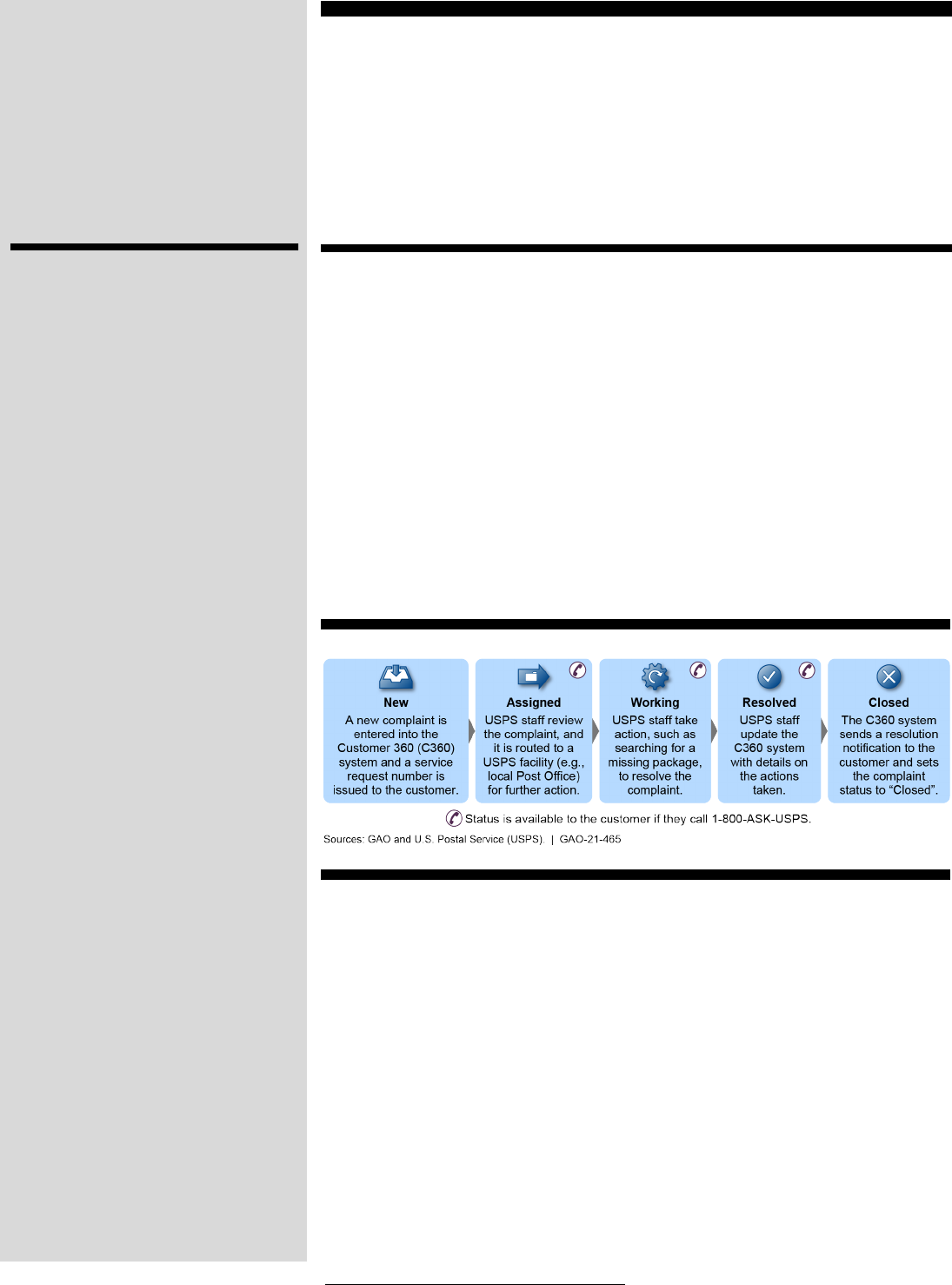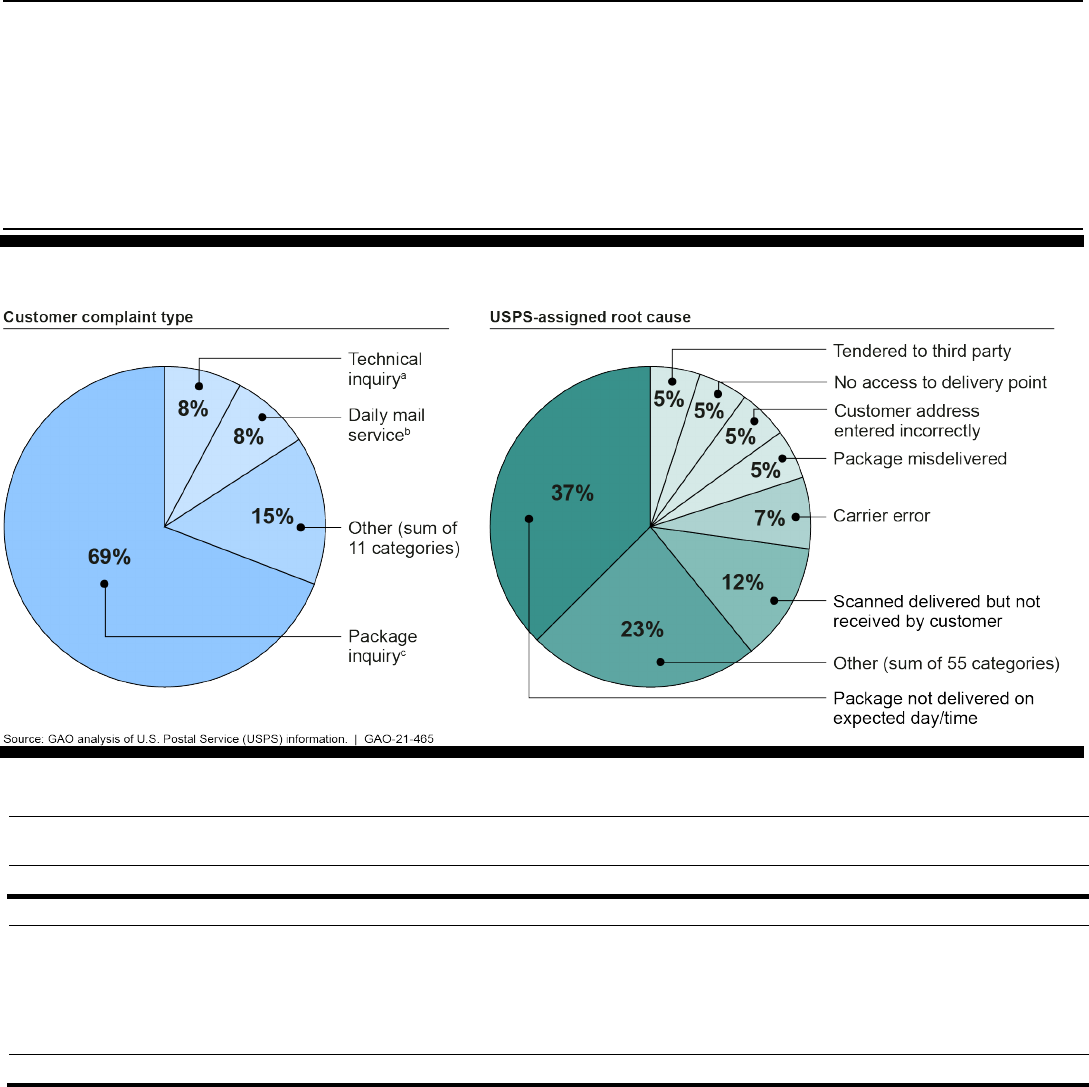
U.S.POSTAL
SERVICE
CustomerComplaints
Process
Accessible Version
ReporttotheChair,Subcommitteeon
EmergingThreatsandSpending
Oversight,CommitteeonHomeland
SecurityandGovernmentAffairs,U.S.
Senate
May 2021
GAO-21-465
United States Government Accountability Office

United States Government Accountability Office
GAOHighlights
Highlights of GAO-21-465, report to the Chair,
Subcommittee on Emerging Threats and
Spending Oversight, Committee on Homeland
Security and Government Affairs, U.S. Senate
May 2021
U.S. POSTAL SERVICE
Customer Complaints Process
What GAO Found
The United States Postal Service (USPS) delivers mail to about 147-million
residential addresses. To help it serve customers, USPS has a 5-step process
for addressing and resolving residential customers’ complaints. USPS defines a
complaint as a reported service issue that is not resolved in a customer’s initial
contact with USPS and requires additional action to resolve. (See figure.) Once a
complaint is received it is assigned to staff best positioned to respond to the
issue. For example, a complaint about a missing package might be referred to a
local Post Office for investigation and resolution if that Post Office was the
destination facility for the package. USPS collects and tracks a range of
customer service and complaint information using a new software system known
as Customer 360 (C360). According to USPS officials, the C360 system, which
USPS started using in 2019, captures more detailed data and has additional data
fields, such as root cause, which may help officials identify service issues and
analyze issues resulting in complaints. USPS officials also noted ongoing efforts
to educate employees on the C360 system through trainings as well as efforts to
collect feedback from users to help enhance the C360 system.
U.S. Postal Service’s Five Step Customer Complaint Process
Text of U.S. Postal Service’s Five Step Customer Complaint Process
1. New.
A new complaint is entered into the Customer 360 (C360) system and
a service request number is issued to the customer.
2. Assigned.
USPS staff review the complaint, and it is routed to a USPS facility
(e.g., local Post Office) for further action.
3. Working.
USPS staff take action, such as searching for a missing package, to
resolve the complaint.
4. Resolved.
USPS staff update the C360 system with details on the actions taken.
Why GAO Did This Study
USPS, one of the largest customer
service organizations in the United
States, has struggled to operate as a
self-financing entity due primarily to
declining mail volumes and increased
costs. USPS has cited providing quality
customer service as one of its goals
and highlights customer service as
important in sustaining its business.
Despite creating an Office of Customer
Experience in 2018, USPS continues
to miss many of its stated goals related
to customer experience and service.
GAO was asked to review how USPS
handles residential customer
complaints, including cases where
customers may be experiencing
repeated service issues. This report (1)
describes USPS’s processes for
addressing and tracking residential
customer complaints and (2) identifies
the number and nature of residential
customer complaints and how USPS
uses residential customer complaint
data. GAO reviewed and analyzed
USPS’s public reports and internal
documents associated with customer
complaints. GAO analyzed customer
complaints data to, among other
things, identify the number of
residential addresses that reported
repeated service complaints in fiscal
year 2020. GAO used fiscal year 2020
data as all data shared the same fields
and were collected under the current
software system. GAO also conducted
interviews with relevant USPS officials
and staff to understand the processes
and tools USPS uses to collect,
address, and monitor complaints.
5. Closed.
The C360 system sends a resolution notification to the customer and
sets the complaint status to “Closed”
Sources: GAO and U.S. Postal Service (USPS). | GAO-21-465
Most of the 10.7-million complaints USPS received in fiscal year 2020 concerned
packages, and USPS analyzes C360 data to monitor timeliness in addressing
these complaints. GAO’s analysis of USPS’s fiscal year 2020 residential
complaints data found a total of 10.7-million residential customer complaints
were reported by about 5.6 percent of the residential addresses USPS served.
Most of these complaints—69 percent—were related to packages, such as
missing or delayed packages. GAO found that about 21 percent of addresses
that reported a complaint had more than one complaint. Of those addresses, a
majority of complaints occurred less than one month apart, and many had two
complaints with the same USPS-assigned root cause. USPS officials are
currently reviewing whether the root cause field is accurately capturing the cause
of a complaint. Across USPS, multiple officials told GAO they use the C360
system’s reporting capabilities to access, review, and analyze complaints data.
USPS officials said that given the size of their operations, it is not realistic to
eliminate all complaints. The Office of Customer Experience monitors and
assesses performance related to timeliness in contacting customers and closing
complaints. Delivery operations staff use complaints data in conjunction with
delivery operations information to identify service issues or specific causes for
increases in complaints.

Page i GAO-21-465 USPS Customer Complaints
Contents
GAO Highlights 2
Why GAO Did This Study 2
What GAO Found 2
Letter 1
Background 4
USPS Has a Residential Complaint Resolution Process and a
New Software System for Tracking Those Customer
Complaints 7
Most of the 10.7-Million Fiscal Year 2020 Complaints Concerned
Packages, and Data Are Used Primarily to Track Performance
in Addressing Customer Complaints 11
Agency Comments 15
Appendix I: GAO Contact and Staff Acknowledgment 17
GAO Contact 17
Staff Acknowledgments 17
Figures
U.S. Postal Service’s Five Step Customer Complaint Process 2
Figure 1: U.S. Postal Service (USPS) Office of Customer
Experience’s Organizational Chart 6
Figure 2: U.S. Postal Service’s (USPS) Reported Residential
Complaints by Complaint Type and USPS-Assigned Root
Cause for Fiscal Year 2020 12
Figure 3: Information on Addresses Reporting Repeat Residential
Customer Complaints to the U.S. Postal Service (USPS)
in Fiscal Year 2020 13

Page ii GAO-21-465 USPS Customer Complaints
Abbreviations
C360 Customer 360
COVID-19 Coronavirus Disease 2019
USPS U.S. Postal Service
This is a work of the U.S. government and is not subject to copyright protection in the
United States. The published product may be reproduced and distributed in its entirety
without further permission from GAO. However, because this work may contain
copyrighted images or other material, permission from the copyright holder may be
necessary if you wish to reproduce this material separately.

Page 1 GAO-21-465 USPS Customer Complaints
441 G St. N.W.
Washington, DC 20548
May 25, 2021
The Honorable Margaret Wood Hassan
Chair
Subcommittee on Emerging Threats and Spending Oversight,
Committee on Homeland Security and Government Affairs
United States Senate
Dear Madam Chair:
The U.S. Postal Service (USPS), one of the largest customer service
organizations in the United States, has struggled to operate as a self-
financing entity due primarily to declining mail volumes and increased
costs. Given USPS’s poor financial condition, USPS’s financial viability
has been on GAO’s list of high-risk areas since 2009.
1
USPS has stated
in its current 5-year strategic plan—for fiscal years 2020 to 2024—that
one of its goals is to provide quality customer service, including improving
how it resolves customer service issues, and also highlights in this plan
that customer service has an important role in sustaining its business.
2
Further, in USPS’s March 2021 10-year plan to achieve financial
sustainability, USPS emphasized that customer service is a key part of its
broader transformation strategy.
3
In 2018, USPS created an Office of Customer Experience to help in
addressing customer service, yet USPS continues to miss many of its
performance goals related to customer experience and service. While
specific situations, such as the Coronavirus Disease 2019 (COVID-19)
pandemic, may lead to service disruptions and increases in residential
customer complaints, there are concerns about residential customers
experiencing repeated service issues.
4
These concerns have led to
1
GAO, High-Risk Series: Dedicated Leadership Needed to Address Limited Progress in
Most High-Risk Areas, GAO-21-119SP (Washington, D.C.: March 2021)
2
USPS, Ready-Now ➔ Future-Ready: The U.S. Postal Service Five-Year Strategic Plan
FY2020-FY2024 (Washington, D.C.: January 2020)
3
USPS, Delivering for America: Our Vision and Ten-Year Plan to Achieve Financial
Sustainability and Service Excellence, (Washington, D.C.: March 2021)
4
GAO, U.S. Postal Service: Volume, Performance, and Financial Changes since the
Onset of the COVID-19 Pandemic, GAO-21-261 (Washington, D.C.: April 2021)
Letter

Letter
Page 2 GAO-21-465 USPS Customer Complaints
questions about USPS’s processes for tracking, monitoring and resolving
residential customer service issues.
You asked us to review how USPS handles residential customer
complaints, including cases where customers may be experiencing
repeated service issues. This report (1) describes USPS’s processes for
addressing and tracking residential customer complaints, and (2)
identifies the number and nature of residential customer complaints and
how USPS uses residential customer complaints data.
For both objectives we reviewed and analyzed USPS public reports—
such as its 2018 through 2020 annual reports to Congress—and internal
documents, such as training materials and user guides associated with
the customer complaints process and its related software system. We
also obtained and reviewed other reports, such as reports from the U.S.
Postal Service Office of Inspector General and the Postal Regulatory
Commission that address topics related to USPS customer service and
customer complaints. We conducted interviews with relevant USPS
officials and staff to understand the processes and tools USPS uses to
collect, address, and monitor these complaints as well as how USPS
uses customer complaint data and USPS’s current and future plans
regarding customer complaint data analysis. These interviews included
staff and officials in the Office of Customer Experience who handle
residential customer complaints, including an Area Marketing Manager,
and an interview with staff and officials in the Office of Delivery
Operations that oversees mail and package delivery and has a role in the
complaint resolution process. We also interviewed officials from the
Postal Regulatory Commission and the U.S. Postal Inspection Service to
discuss their roles in the customer complaint process.
To examine the extent to which customers reported repeated service
complaints we analyzed USPS customer complaints data.
5
USPS officials
told us the system retains 3 years of complaints data on a rolling basis.
We reviewed and analyzed USPS customer complaint data from the
second quarter of fiscal year 2018 through the end of fiscal year 2020.
We are only reporting fiscal year 2020 information because USPS
launched a new software system in August 2019 that resulted in some
incomplete or changed data fields. In fiscal year 2020, all data shared the
5
For the purposes of this analysis, we define repeated customer complaints as more than
one complaint at the same address in fiscal year 2020.

Letter
Page 3 GAO-21-465 USPS Customer Complaints
same fields and were collected under the current software system.
6
We
analyzed fiscal year 2020 customer complaint data to determine the
following:
· The total number of reported customer complaints, including by
complaint type.
· The number of residential addresses that reported one or more
complaints, as well as the total number and time interval for
consecutive complaints at addresses that reported more than one
complaint.
7
· The number of residential addresses that reported at least two
complaints in less than a 30-day period with the same root cause
recorded.
8
We also interviewed USPS staff to discuss the customer complaints
software system, the data USPS provided from the system, and topics
related to data reliability. We determined the data are reliable for our
purposes of describing the number and nature of residential customer
complaints.
We conducted this performance audit from May 2020 to May 2021 in
accordance with generally accepted government auditing standards.
Those standards require that we plan and perform the audit to obtain
sufficient, appropriate evidence to provide a reasonable basis for our
findings and conclusions based on our audit objectives. We believe that
the evidence obtained provides a reasonable basis for our findings and
conclusions based on our audit objectives.
6
This time period would include the COVID-19 pandemic, but we did not asses how the
pandemic might have affected the number of reported complaints.
7
Our analysis of the time interval between complaints compared consecutive complaints,
meaning the time frame could have occurred at any point during the fiscal year.
8
Because not all complaints had a root cause denoted, we only considered records that
had a root cause selected for both the first and second complaints.

Letter
Page 4 GAO-21-465 USPS Customer Complaints
Background
USPSMissionandCustomers
USPS’s mission is to provide prompt, reliable, and efficient universal
postal service, and federal statute requires USPS to “provide postal
services to bind the Nation together through the personal, educational,
literary, and business correspondence of the people.”
9
USPS is required
to serve, as nearly as practicable, the entire population of the United
States.
10
USPS is also the largest postal operator in the world, with over
495,000 career employees and delivering an estimated 43 percent of all
mail sent globally. In fiscal year 2020, USPS reported a total mail and
package volume of over 129 billion items.
To help deliver mail to about 147-million residential addresses in the
United States, USPS has a geographically distributed workforce and
infrastructure.
11
USPS has divided the country into four Retail and
Delivery Operations Areas.
12
Within those areas, there are a total 50
Districts, which in turn contain over 34,000 Post Offices, supporting about
232,000 delivery routes.
USPS officials said there are two primary categories for its customers:
business and residential. Business customers can range from small
businesses to large corporations and retailers that use USPS services.
These customers send and receive mail, such as bills, advertisements,
and packages. Residential customers—who are the focus of this report
9
39 U.S.C. § 101(a).
10
39 U.S.C. § 403(a). USPS’s universal service obligation is governed by several
statutory provisions, including the requirement to provide a maximum degree of effective
and regular postal services to rural areas, communities, and small towns where post
offices are not self-sustaining. See 39 U.S.C. §§ 101(b), 3691(b)(1)(B).
11
The total number of residential addresses was provided by USPS and accounts for
about 131 million physical residences as well as about 16 million post office boxes they
attribute to residential use.
12
The four USPS Retail and Delivery Operations Areas are: Atlantic, Central, Southern,
and Western-Pacific.

Letter
Page 5 GAO-21-465 USPS Customer Complaints
and the customers we will be discussing throughout—are generally
individuals or families.
13
They send and receive mail and packages, but it
is often at lower volumes than a business customer.
USPSCustomerService
USPS has identified providing quality experience—which includes
customer service as a goal in its Annual Reports to Congress. In its fiscal
year 2020 annual report to Congress, USPS noted that to evaluate
customers’ satisfaction with USPS services, customers are surveyed at
seven key interaction points with the results from those seven surveys
generating a Customer Experience Composite Index score.
14
According
to USPS officials, this Index is designed to be a high-level indicator of
customer satisfaction with USPS services. Customer complaints data are
one component of the overall Index score. The target and actual scores
for each of the seven surveys and the Customer Experience Composite
Index score are reported in USPS’s annual report to Congress. The fiscal
year 2020 report showed a higher (better) overall Composite Index score
than the prior year, though the score was lower than USPS’s stated
goal.
15
However, the Customer Experience Composite Index does not
capture other elements of USPS performance—such as not meeting any
of its fiscal year 2020 targets for on-time mail delivery and its ongoing
financial difficulties.
In 2018, USPS created the Office of Customer Experience and an
associated Vice President position. According to the USPS website, the
Vice President and this office are charged with developing an effective
customer strategy that drives a customer focus into all aspects of USPS.
The Vice President and this office are responsible for oversight of
Customer Experience Composite Index surveys, as well as for oversight
13
USPS officials noted that some micro-businesses or home-based small businesses
may be reflected in the residential customer complaint data as they are using USPS
services more like a residential customer than a business.
14
The seven surveys for fiscal year 2020 were: (1) Business Service Network, (2) Point of
Sale, (3) Delivery, (4) Customer Care Center, (5) Customer 360, (6) USPS.com, and (7)
Business Mail Entry Unit. In fiscal year 2019, the Customer 360 survey was named
Enterprise Customer Care for the prior software system that managed complaints, but
definition of the survey as a metric for customer experience did not change.
15
In fiscal year 2020, the Customer Experience Composite Index score was 72.4 out of a
target of 75.7 compared to the fiscal year 2019 score of 69 out of a target of 78.3.
Additionally, of the 8 metrics reported, in fiscal year 2020 USPS met 4 of 8 metrics
compared to the prior year’s 2 out of 8 metrics met.

Letter
Page 6 GAO-21-465 USPS Customer Complaints
of the customer complaint process and the software tool used to address
and monitor residential customer complaints. This office also manages
the USPS Customer Care Centers that receive customer calls, Area
Marketing Managers who have a key role in the customer complaints
process, and the Consumer Advocate department. This office reports to
the Chief Customer and Marketing Officer and Executive Vice President.
Figure 1 below shows the Office of Customer Experience organizational
structure, including the different offices contained within it.
Figure 1: U.S. Postal Service (USPS) Office of Customer Experience’s
Organizational Chart
Text of Figure 1: U.S. Postal Service (USPS) Office of Customer Experience’s
Organizational Chart
1) Office of Customer Experience
a) Area Marketing Managers
b) Consumer Advocate
c) Customer experience and strategy
d) Enterprise customer care
i) customer care support
ii) customer care centers
e) Program management office
As we discuss later in the report, there are other staff who are not part of
the Office of Customer Experience but are involved in providing customer
service and resolving complaints.

Letter
Page 7 GAO-21-465 USPS Customer Complaints
USPSHasaResidentialComplaintResolution
ProcessandaNewSoftwareSystemfor
TrackingThoseCustomerComplaints
USPSUsesaDefinedProcesstoAddressResidential
CustomerComplaints
USPS uses a five-step process to address and track customer
complaints. USPS considers a complaint to be a reported service issue
that cannot be resolved during the customer’s initial contact and that
Mail Theft and Other Mail-Related Criminal
Investigations
Two U.S. Postal Service (USPS) affiliated
entities have a role in handling certain
customer concerns. The U.S. Postal
Inspection Service and the U.S. Postal
Service Office of Inspector General handle
customer contacts where theft of mail is
suspected. They refer any other delivery
service issues they receive from customers to
USPS for further assistance.
U.S. Postal Inspection Service: investigates
criminal matters—such as theft of mail or other
mail-related criminal activity—committed by a
non-USPS employee. If a customer were to
report an issue where criminal activity is
suspected, USPS would forward the complaint
to the U.S. Postal Inspection Service for
further action. The U.S. Postal Inspection
Service maintains a separate database for
tracking and addressing criminal complaints.
Additionally, USPS works with staff from the
U.S. Postal Inspection Service to provide
customer complaints data that could aid U.S.
Postal Inspection Service in intelligence
gathering efforts to track potential mail and
package thefts.
U.S. Postal Service Office of Inspector
General: investigates cases where suspected
theft of mail or mail-related criminal activity
involves a USPS employee. The U.S. Postal
Service Office of Inspector General also
investigates service issues at individual postal
facilities. These investigations may be sparked
by customer complaints. The resulting reports
often have recommendations for action and
are available to the public on the U.S. Postal
Service Office of Inspector General website.
Source: GAO analysis of U.S. Postal Inspection Service and
U.S. Postal Service Office of Inspector General information. |
GAO-21-465

Letter
Page 8 GAO-21-465 USPS Customer Complaints
requires further action by USPS staff to resolve it.
16
According to USPS
officials, the basic complaint process has been the same for a number of
years, but the software system used to support the process—the
Customer 360 (C360) system discussed in greater detail later in the
report—is new. The five steps in the process have corresponding
statuses in the C360 software system. If theft or criminal activity were
suspected as the cause of the customer’s complaint, the issue would be
forwarded to either the U.S. Postal Inspection Service or the U.S. Postal
Service Office of Inspector General for further action. (See sidebar for
further information.)
Management and staff in the Office of Customer Experience oversee the
process for collecting, addressing, and monitoring residential customer
service complaints, and told us they are in close contact with other staff
and USPS offices involved in the process.
17
The steps in this process are:
1. New. A customer’s issue that cannot be resolved during the initial
contact with USPS is considered a new complaint and a service
request is initiated in C360. C360 assigns a service request number to
track the complaint.
2. Assigned. USPS staff, usually at the call centers, route the complaint
to either the District Consumer and Industry Contact office or a Post
Office. Staff at these offices are responsible for contacting the
customer within one business day to provide the service request
number and collect any additional information. Staff in these offices
are also responsible for coordinating a resolution to the issue.
3. Working. The assigned staff investigate and coordinate with others
as appropriate to identify and resolve the issue. This may include
reaching out to staff at a sorting facility to check package scanning
data or search the facility to locate a missing package. The USPS
16
In fiscal year 2020, USPS reported to GAO that residential customers most frequently
contacted USPS about service issues by calling a service center or messages and email
sent through USPS.com—an option that became available in fiscal year 2019. In addition
to phone and email contacts, USPS also tracks customer contacts made through online
chat, letters, in-person contacts such as at local Post Offices, as well as complaints
forwarded by the Office of Inspector General, Postal Regulatory Commission inquiries,
and Congressional Offices. Business customers have additional avenues for reporting a
service issue to USPS, such as accessing the USPS Business Customer Gateway.
17
USPS officials told us the process for handling business complaints is similar but, other
than very small business operators, business customer service would be handled in
another office using a system similar to C360.

Letter
Page 9 GAO-21-465 USPS Customer Complaints
staff who are assigned to the complaint then record the details of the
actions in C360.
4. Resolved. Once the assigned staff determine the actions taken have
resolved the issue, they update C360 with additional details including
resolution information from pre-populated dropdown menus. After staff
enter resolution information into C360, the system updates the status
to “resolved”. Staff may also use fields that allow notes to capture
relevant details about the action taken or possible cause of the
complaint.
5. Closed. After C360 updates the complaint status to “resolved,” it
automatically sends a final resolution communication to the USPS
customer via the customer’s preferred contact method, letting the
customer know the issue has been resolved. The system updates the
complaint’s status to “closed”.
If customers are not satisfied with how a complaint was resolved, the
customer can reply to USPS via email or phone to state that they do not
think the issue has been resolved. Such a reply would trigger the C360
system to change the complaint status to “Reopened” and the complaint
would be sent back to USPS staff for further action, such as additional
investigation into the complaint. USPS reported to us that about 3 percent
of all the complaints received in fiscal year 2020 were reopened.
USPSUsesaNewSoftwareSystemtoTrackCustomer
Complaints
USPS officials told us that they started to use their new C360 software
system in August 2019 and that they view it as an integral tool in the
customer complaint process, allowing USPS to collect and track customer
service data. Customer service data can be used for a variety of
purposes, as we discuss later in this report.
18
The officials told us that the
main purpose of C360 is to collect and track complaints information to aid
in resolving specific customer complaints as expediently as possible.
USPS officials said the new system has a number of benefits, among
them that the C360 system captures more detailed data as well as
additional data fields than the prior system. The officials said the
additional information helps them to resolve complaints and analyze
18
USPS officials told us the USPS replaced its prior system because it was obsolete and
no longer supported by the manufacturer.

Letter
Page 10 GAO-21-465 USPS Customer Complaints
complaint data. For example, the prior system had five broad categories
for the type of complaints, while the new system has 14 categories.
Officials said this helps USPS staff better categorize and route complaints
to the facility and staff best able to address the issues.
19
For example, the
type of action needed or staff involved in resolving a Package Inquiry
complaint (e.g., searching a facility for a package) would be different from
handling a Change of Address complaint (e.g., updating an address entry
in a computer system).
Similarly, the added data fields in the C360 system, including a root
cause field, allow staff to capture more detailed information about the
nature of the reported issue and its resolution. In most cases, before
USPS staff resolve and close a complaint in C360, they must select a root
cause from a pre-populated drop-down menu of phrases intended to
briefly summarize the suspected reason for the complaint.
20
USPS
officials said that the “root cause” field is often more of an additional
descriptive field than something that is actionable and solves for
underlying issues leading to service issues. Officials said this field was
added in 2019 in part to aid in internal analysis of and reporting on
complaints. Officials in the Office of Customer Experience told us they are
currently reviewing the root cause field specifically to determine if the data
collected are adequately capturing the cause of complaints and to
understand the number of complaints based on the noted root cause.
They anticipate having results by the end of calendar year 2021.
USPS officials also noted that the C360 system provided reporting
capabilities not available with the previous system. The C360 system can
generate standard reports for users and also allows users to generate
custom reports by selecting specific data fields. Users can access data
and run reports at the National, Area, District, and facility levels. As we
discuss below, these reports can be used to monitor USPS performance
for addressing customer complaints.
According to officials in the Office of Customer Experience, they are
continuing to educate users on the capabilities of the C360 system and to
enhance the system. To improve issue resolution, the officials said they
19
The 14 categories, called Case Inquiry Type in the C360 system are: Personnel,
General Inquiry, Package Inquiry, Redelivery, Technical Inquiry, Business Inquiry, Change
of Address, Daily Mail Service, Facility, GXC Escalation, Hold Mail, Package Pickup,
Premium Forwarding Service, and Stamps Fulfillment Service Inquiry.
20
A root cause is not required for complaints in the Business, Personnel, or Premium
Forwarding Service categories.

Letter
Page 11 GAO-21-465 USPS Customer Complaints
plan to develop supplemental-training materials and guides for users. In
addition, officials said they plan to create two cross-functional teams of
subject matter experts to coach and train personnel who use the C360
system and address complaints. Currently, the Office of Customer
Experience uses teleconferences and email to provide regular updates on
system capabilities and enhancements as well as providing avenues,
such as an email point of contact to collect feedback on the system from
the users. These efforts help ensure all users are up to date with the
C360 system and its capabilities as well as provide information to inform
system enhancements. In late 2020, the Office of Customer Experience
formed an executive-level C360 steering committee to improve the overall
user experience and take a strategic look at the C360 system and the
data it collects. As a part of this effort, the steering committee launched a
C360 working group to collect information from C360 users about their
experiences with the system to help the committee understand how users
access and use system data and areas that users think could be
enhanced.
Mostofthe10.7MillionFiscalYear2020
ComplaintsConcernedPackages,andData
AreUsedPrimarilytoTrackPerformancein
AddressingCustomerComplaints
InFiscalYear2020Over7MillionComplaintsWere
PackageInquires,andMostRepeatComplaintsOccurred
within30Days
Most of the 10.7-million residential customer complaints USPS received
in fiscal year 2020—69 percent—were package inquiries and the leading
reason for complaints recorded in the USPS-assigned root cause field
was “package not delivered on expected delivery day/ time.” Those
complaints came from 8.2-million residential addresses, or about 5.6
percent of the total 147-million residential addresses USPS serviced that
year. Figure 2 below shows all complaints received in fiscal year 2020 by
the type of complaint and the USPS-assigned root causes.

Letter
Page 12 GAO-21-465 USPS Customer Complaints
Figure 2: U.S. Postal Service’s (USPS) Reported Residential Complaints by Complaint Type and USPS-Assigned Root Cause
for Fiscal Year 2020
Data table for Figure 2: U.S. Postal Service’s (USPS) Reported Residential Complaints by Complaint Type and USPS-Assigned
Root Cause for Fiscal Year 2020
Customer complaint type
Technical inquiry
Daily mail service
Other (sum of 11
categories)
Package inquiry
Percentage
8
8
15
69
UPS-
assigned root
cause
Tendered to
third party
No
access to
delivery
point
Customer
address
entered
incorrectly
Package
misdelivered
Carrier
error
Scanned
delivered
but not
received by
customer
Other (sum
of 55
categories
Package
not
delivered
on
expected
day/time
Percentage
5
5
5
5
7
12
23
37
a
Technical inquiry includes any calls and complaints related to USPS.com functions and services.
b
Daily mail service includes all complaints related to mail delivery, including damaged or missing mail.
c
Package inquiry includes any complaint regarding a package, excluding package pick-up request
complaints.
Our analysis of USPS’s fiscal year 2020 residential customer complaint
data showed that of the addresses reporting multiple complaints, most
reported the next complaint within 30 days. In addition, USPS assigned
the same root cause to many of the subsequent complaints. Specifically,
our analysis showed that 1.7-million (about 21 percent) of the 8.2-million
residential addresses that reported a complaint in fiscal year 2020

Letter
Page 13 GAO-21-465 USPS Customer Complaints
reported more than one complaint in that year.
21
Of the 1.7-million
addresses with multiple complaints, we found that 66 percent reported
those complaints less than one month apart. We also found that roughly
41 percent of the repeat complaints were assigned the same root cause
by USPS. (See fig. 3.) The same root cause for recurring complaints may
indicate that even though the initial complaint was “resolved” by USPS,
the underlying issue that led to the complaint had not been addressed. As
noted above, USPS officials are reviewing the root cause field specifically
to determine if the data collected are adequately capturing the cause of
complaints.
Figure 3: Information on Addresses Reporting Repeat Residential Customer Complaints to the U.S. Postal Service (USPS) in
Fiscal Year 2020
Data table for Figure 3: Information on Addresses Reporting Repeat Residential Customer Complaints to the U.S. Postal
Service (USPS) in Fiscal Year 2020
Complaint category
Number (in
millions)
Percentage
Addresses reporting at least one complaint
8.16
-
Addresses reporting more than one complaint
1.72
21% of addresses reporting at least one complaint
Addresses reporting more than one complaint in less
than a month
1.13
66% of addresses reporting more than one complaint
Addresses reporting exactly two complaints in less than a
month
0.84
74% of addresses reporting more than one complaint in
less than a month
21
Our analysis does not include reopened complaints. As described earlier in this report,
reopened complaints are instances when USPS considered a complaint resolved, but the
customer did not agree and contacts USPS to have it reopened.

Letter
Page 14 GAO-21-465 USPS Customer Complaints
Complaint category
Number (in
millions)
Percentage
Addresses reporting two complaints with the same root
cause
0.28 of 0.68
41% of addresses reporting exactly two complaints in less
than a month
a
Not all complaints had a root cause selected. This population reflects records that had a root cause
selected for both the first and second complaints.
USPSOfficialsUseComplaintsDatatoMonitor
TimelinessinAddressingComplaintsandtoIdentifyAreas
forAdditionalAttention
USPS officials noted that given the size of their operations and the
volume of mail and package deliveries, it is not realistic to eliminate all
complaints. Instead, they said the focus is on meeting their metrics to
address and resolve complaints quickly because they believe these
metrics correlate with customer satisfaction and a positive customer
experience. To do this, offices and staff at all levels of the organization
can access complaints data and the C360 system. USPS officials
reported using the data to monitor timeliness in addressing complaints or
in conjunction with other USPS data and information to examine service
issues.
Officials in the Office of Customer Experience told us they primarily use
customer complaint data as a performance indicator. As noted above, the
main purpose of the C360 system and its resulting data on complaints is
to address and track individual complaints as they move through the
complaint resolution process. The officials in the Office of Customer
Experience said they use C360 data to track the extent to which
customers are contacted within one business day of making a complaint
and the extent to which complaints are closed within 3 business days.
USPS officials in the Office of Customer Experience told us that in fiscal
year 2020 their goal was 100 percent timeliness for both the initial contact
and complaint closure metrics, and that they met the initial contact metric
82 percent of the time and the 3-days-to-close metric 76 percent of the
time.
22
An Area Marketing Manager we spoke with gave an example of how
officials at the Area level use standard system reports to view the volume
22
USPS officials said that in early fiscal year 2020 there was a system issue that resulted
in some residential customer complaints not having the initial contact’s date field
completed. Those cases are excluded from the reported percentages.

Letter
Page 15 GAO-21-465 USPS Customer Complaints
of complaints in their Area that are due for initial contact or resolution on
any given day and the progress toward meeting certain metrics. The Area
Marketing Manager said that these reports can be analyzed at the
national level—which can give managers and staff in Areas and Districts
a sense of how their performance compares to other Areas and
Districts—as well as at the Area and District levels. Additionally, he noted
that Areas and Districts use these reports as an indicator of their
timeliness performance. The Area Marketing Manager stated that twice a
day, his office sends the reports to Districts for review and action as
appropriate. These reports enable the District to take immediate action if
it is not meeting the goals and can be used to identify trends in
performance on a weekly or monthly basis.
USPS officials from the Office of Delivery Operations stated they use
customer complaint data, in conjunction with other data systems, as an
indicator of their delivery service performance. They said that complaint
data alone do not provide much insight into overall service issues but
when combined with data from other systems it can provide additional
context that can help officials identify and address service issues. For
example, officials in the Office of Delivery Operations told us they use
complaint data, along with data from other systems, to understand
delivery performance at the District level. They said they use customer
complaint data on the volume of complaints to create a list of the 25
Districts that have the highest number of reported complaints. These
officials told us that with this list as a starting point, Area and District staff
can use other data systems to identify the specific delivery routes
contributing to the number of complaints. For example, staff can combine
complaint data with package scanning data to identify a route or facility
that is experiencing package backlogs. In this way, officials in the Office
of Delivery Operations said that they and the officials at the District level
can use the list to understand their performance and focus resources on
addressing service issues to reduce complaints and improve the District’s
ranking. Their goal is to reduce the rate of complaints since officials do
not expect to be able to eliminate all complaints given the nature and
volume of mail services.
AgencyComments
We provided a draft of this report to USPS for comment. USPS provided
technical comments, which we incorporated as appropriate.

Letter
Page 16 GAO-21-465 USPS Customer Complaints
As agreed with your office, unless you publicly announce the contents of
this report earlier, we plan no further distribution until 30 days from the
report date. At that time, we will send copies to the appropriate
congressional committees, the Postmaster General, and other interested
parties. In addition, the report will be available at no charge on the GAO
website at https://www.gao.gov.
If you or your staff have any questions about this report, please contact
Offices of Congressional Relations and Public Affairs may be found on
the last page of this report. GAO staff who made key contributions to this
report are listed in appendix II.
Sincerely yours,
Jill Naamane
Acting Director, Physical Infrastructure Issues

Appendix I: GAO Contact and Staff
Acknowledgment
Page 17 GAO-21-465 USPS Customer Complaints
AppendixI:GAOContactand
StaffAcknowledgment
GAOContact
Jill Naamane, (202) 512-2834 or [email protected]ov
StaffAcknowledgments
In addition to the contact named above, Maria Edelstein (Assistant
Director); Betsey Ward-Jenks (Analyst in Charge); Melissa Bodeau;
Geoffrey Hamilton; Serena Lo, Joshua Ormond; Michael Soressi, Breana
Stevens; Janet Temko-Blinder and John Yee made key contributions to
this report.
(104345)

GAO’sMission
The Government Accountability Office, the audit, evaluation, and investigative
arm of Congress, exists to support Congress in meeting its constitutional
responsibilities and to help improve the performance and accountability of the
federal government for the American people. GAO examines the use of public
funds; evaluates federal programs and policies; and provides analyses,
recommendations, and other assistance to help Congress make informed
oversight, policy, and funding decisions. GAO’s commitment to good government
is reflected in its core values of accountability, integrity, and reliability.
ObtainingCopiesofGAOReportsandTestimony
The fastest and easiest way to obtain copies of GAO documents at no cost is
through our website. Each weekday afternoon, GAO posts on its website newly
released reports, testimony, and correspondence. You can also subscribe to
GAO’s email updates to receive notification of newly posted products.
OrderbyPhone
The price of each GAO publication reflects GAO’s actual cost of production and
distribution and depends on the number of pages in the publication and whether
the publication is printed in color or black and white. Pricing and ordering
information is posted on GAO’s website, https://www.gao.gov/ordering.htm.
Place orders by calling (202) 512-6000, toll free (866) 801-7077, or
TDD (202) 512-2537.
Orders may be paid for using American Express, Discover Card, MasterCard,
Visa, check, or money order. Call for additional information.
ConnectwithGAO
Connect with GAO on Facebook, Flickr, Twitter, and YouTube.
Subscribe to our RSS Feeds or Email Updates. Listen to our Podcasts.
Visit GAO on the web at https://www.gao.gov.
ToReportFraud,Waste,andAbuseinFederal
Programs
Contact FraudNet:
Website: https://www.gao.gov/about/what-gao-does/fraudnet
Automated answering system: (800) 424-5454 or (202) 512-7700

CongressionalRelations
Orice Williams Brown, Managing Director, W[email protected], (202) 512-4400,
U.S. Government Accountability Office, 441 G Street NW, Room 7125,
Washington, DC 20548
PublicAffairs
Chuck Young, Managing Director, [email protected], (202) 512-4800
U.S. Government Accountability Office, 441 G Street NW, Room 7149
Washington, DC 20548
StrategicPlanningandExternalLiaison
U.S. Government Accountability Office, 441 G Street NW, Room 7814,
Washington, DC 20548
